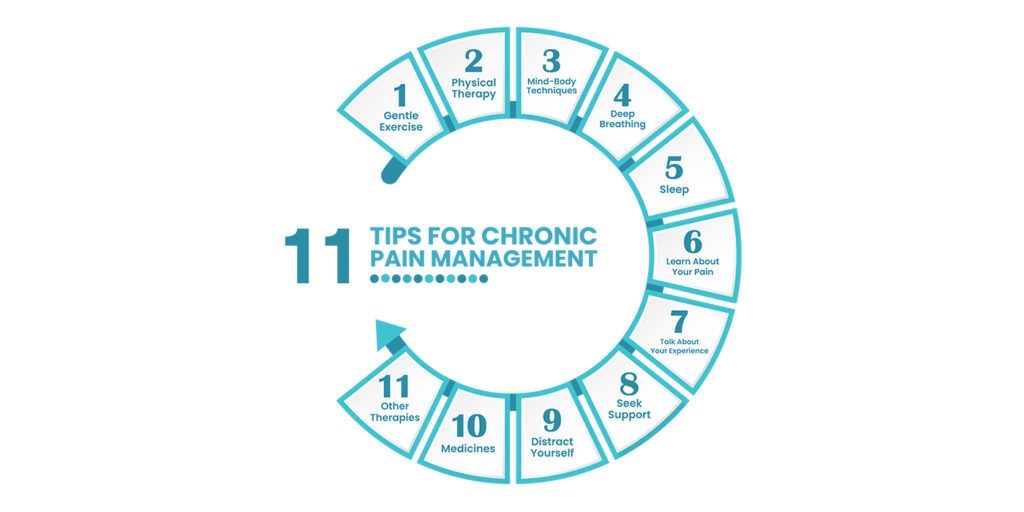Chronic pain is a debilitating condition that affects millions of people globally. It can be a constant companion, disrupting your daily life and making your everyday activities a challenge. However, by using the right combination of chronic pain management techniques & therapies you can alleviate your pain and take charge of your well-being. There are various types of chronic pain that need to be treated and managed effectively.
Here are some effective and proven chronic pain management techniques for you, so you can enjoy a pain free life.

1. Gentle Exercise:
While dealing with chronic pain, it is natural to avoid movement due to fear of making your pain worse. However, a lack of physical activity can contribute to this problem by causing muscle stiffness, joint immobility, and muscles and bone weakness. All of this can intensify your pain over time.
Doing gentle and low-impact exercises that do not put too much strain on your body, can be a highly effective way to manage or even reduce your pain.
Physical activities like walking, swimming, and cycling help loosen stiff muscles, ligaments and joints. Regular movement also stimulates production of endorphins which are the body’s natural pain killers and can even help block pain signals from reaching the brain.
Always start slowly and gradually increase your activity level to avoid worsening any existing pain.
2. Physical Therapy:
Physical therapy can help strengthen weak muscles and improve flexibility which can reduce your pain. A short course of physical therapy can help improve mobility and make daily activities easier.
Through a combination of therapies such as stretching, guided movement, posture correction, and targeted pain relief techniques like heat, cold, and manual therapy you can have noticeable improvement in your pain and mobility. You can start feeling better within a few sessions after doing physical therapy.
Experts like physiotherapists, chiropractors and occupational therapists can advise and help you with these therapies.
3. Mind-Body Techniques:
These techniques include:
- Cognitive Behaviour therapy (CBT):
CBT helps manage long term pain by addressing the impact of pain on mental and emotional health. It helps by changing negative thoughts, stress and feeling of helplessness. It also helps to relieve anxiety, frustration and depression related to the pain and improves overall well-being.
- Yoga
Yoga focuses on relaxation, strength and flexibility through stretching exercises. Different yoga poses target different areas of the body. It is a safe and accessible pain management technique that can be performed at home using online resources or in a class with an instructor.
- Tai Chi
It is a Chinese martial art that has evolved into a low-impact, slow moving exercise. It helps by combining gentle movements, deep breathing and mindfulness. It is an adaptable exercise that is suitable for people of all ages and fitness levels. It can be performed in a class or at home.
4. Deep Breathing:
Focusing on your breathing can be helpful during pain. Intense pain can often lead to shallow, rapid breathing which causes dizziness, anxiety, and panic.
Practice slow, deep breathing to remain calm and in control. You can do it by following these simple steps;
- Find a comfortable and quiet place to lie down
- Close your eyes, if you feel comfortable doing so
- Inhale slowly through your nose, allowing your belly (not just your chest) to rise
- Hold your breath for about 2 to 3 seconds
- Exhale slowly through your mouth
- Repeat this cycle for 5 to 10 minutes
This technique promotes relaxation and helps prevent muscle tension from worsening the pain.
5. Sleep:
A good sleep plays an important role in long term pain management by promoting physical and emotional well-being.
Studies show that lack of sleep can decrease pain threshold and intensify the pain. It is important to have adequate and quality sleep as it helps the brain to regulate pain perception. It also promotes tissue repair and reduces inflammation.
To improve your sleep quality you can try to;
- Keep your room quiet, dark, and comfortable for sleep
- Make a regular sleep schedule by going to bed and waking up around the same time everyday
- Create a relaxing bedtime routine like reading a book or taking a warm shower before bed
- Limit screen time at least an hour before your sleep time
- Avoid taking caffeine, alcohol, and heavy meal before going to bed
6. Learn about your Pain:
Learning about your pain, symptoms and triggers can help you manage your pain in a better way. Read booklets and leaflets about your pain to gain more knowledge. Understanding your pain reduces its fear and anxiety, which makes it easier to cope with it.
7. Talk about your Experience:
Talking about your pain with someone can help you manage your pain. Someone who has had a similar experience can understand better what you are going through. Talking can help relieve emotional burden and gain insights.
8. Seek Support:
Don’t let your pain isolate you from your friends and family. Social connections are important for both physical and mental well-being. Seek support from your loved ones for coping with your pain. It can improve your mood, reduce feelings of loneliness and enhance your overall health.
9. Distract Yourself:
Distract yourself from pain by engaging in activities of your interest that bring you joy. Even with limited mobility you can do various creative activities like photography, painting and crafting. This will make you feel better and shift your focus away from your pain.
10. Medicines:
Other than trying natural chronic pain management techniques, you can also use over the counter painkillers.
- Over the counter painkillers such as NSAIDS (aspirin and ibuprofen) and acetaminophen, can help manage the pain.
- Prescription medicines like opioids or muscle relaxants may also be necessary in some cases.
- Prescription anti-depressants can also play a role in pain management for some people. These medicines increase naturally produced neurotransmitters like serotonin and nor-epinephrine, which play a part in pain management.
Remember to take pain killers in recommended doses and intervals. Don’t wait until your pain is severe, take pain killers early to manage flare ups or prepare for activities.
Consult with your healthcare provider before taking medicines.
11. Other Therapies:
- Acupuncture:
Acupuncture is an ancient practice rooted in Traditional Chinese Medicine. It involves the insertion of thin needles into specific points in the body to stimulate healing and pain relief. If you want to try acupuncture therapy you should first consult with your healthcare provider.
- Massage Therapies:
Massage therapy involves manipulation of soft tissues to promote relaxation, reduce muscle tension and improve circulation.
Different massage techniques help relieve chronic pain by targeting deep muscle tension. You can try methods like deep tissue massage, acupressure, and trigger pointing. These methods apply deep pressure to underlying muscles and connective tissues to relieve the source of chronic pain.
- Aromatherapy:
It involves the use of essential oils to promote relaxation, reduce stress and anxiety and improve mood. Studies have shown the positive effect of aromatherapy in reducing the pain.
Oils like lavender, peppermint, and chamomile have calming and anti-inflammatory effects and can be used in aromatherapy to support relaxation and pain relief.
- Herbal Remedies:
Plants have long been used for their healing properties. Certain herbs like turmeric and ginger offer natural pain relieving and anti-inflammatory benefits.
You can make turmeric tea or add turmeric in milk (golden milk) and drink it. You can also add a pinch of turmeric in your food like soups, curries, and smoothies.
You can brew fresh ginger tea or add slices of ginger in your food and consume it.
Final Thoughts:
Chronic pain is a complex condition that requires a multidisciplinary approach to management. By combining the chronic pain management techniques, therapies and medications, one can find relief and improve the quality of their life.
Remember to consult with a healthcare professional if you are having difficulty managing your pain or your pain is getting worse.
With the right approach, it is possible to manage chronic pain and live a happy and healthy life!
If you are suffering from chronic pain and need some time off work or school to recover, you might need a sick note to officially communicate your absence. You can get a sick note online within minutes from an EU licensed doctor from the comfort of your home.








